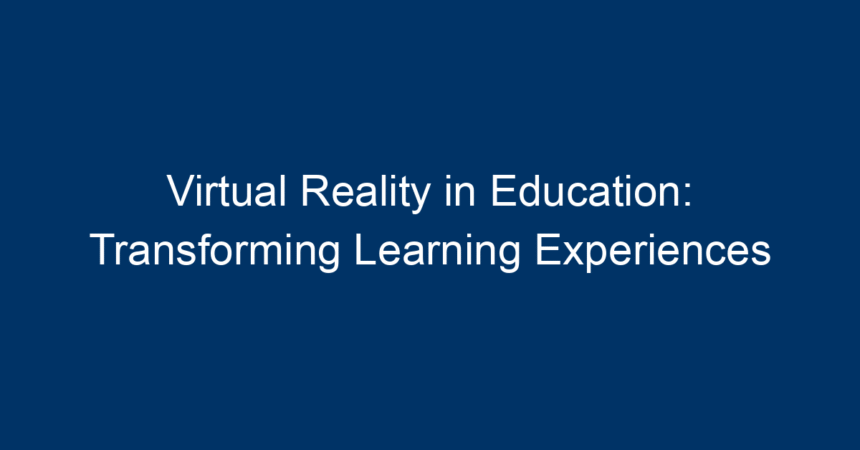In the rapidly evolving landscape of technology, virtual reality (VR) stands out as a groundbreaking tool that has the potential to revolutionize education. By immersing students in simulations of real-world scenarios, virtual reality in education is changing how knowledge is imparted, experiences are shared, and skills are developed. This article explores the transformative power of VR in learning environments, highlighting its benefits, applications, and future prospects.
What is Virtual Reality in Education?
Virtual Reality in education involves the use of VR technology to create immersive, interactive environments where students can engage in learning experiences that would otherwise be impossible or impractical. Unlike traditional educational methods, VR enables learners to encounter concepts through a 3D lens, offering a unique tactile and spatial dimension to their studies.
The Rise of Virtual Reality in Education
The advent of more affordable VR hardware and software has spurred interest in incorporating this technology into the classroom. Educational institutions, from elementary schools to universities, are beginning to harness the potential of VR for a variety of disciplines. The accessibility and engagement factors make VR an attractive alternative to conventional teaching methods.
Benefits of Virtual Reality in Education
1. Enhanced Engagement
One of the most significant advantages of virtual reality in education is its ability to captivate students. Traditional teaching can sometimes be monotonous, leading to disengagement. VR, however, immerses students in dynamic environments that encourage active participation. For example, a history lesson can transform into a virtual tour of ancient Rome, where students can explore significant landmarks while interacting with historical figures.
2. Improved Retention of Information
Studies suggest that experiential learning allows for better information retention. When students physically engage with the content, they are more likely to remember it. VR enables learners to visualize and interact with concepts—like the structure of a cell or the theory of relativity—making complex ideas easier to grasp and recall.
3. Personalization of Learning Experiences
Every learner is unique, with varying preferences and paces of learning. VR technologies facilitate personalized education. Students can engage in tailored experiences that adapt to their needs, allowing them to explore topics in-depth at their own speed. In subjects like math or science, this can significantly enhance understanding and skill mastery.
4. Safe Simulation of Real-life Scenarios
In fields such as medicine, engineering, or aviation, practical experience is crucial. VR allows students to practice skills in a safe environment without the risks associated with real-world training. Medical students can perform virtual surgeries, pilots can fly simulated aircraft, and engineers can test designs, all while receiving immediate feedback.
Applications of Virtual Reality in Education
1. Science and Medicine
In medical schools, VR is used to simulate surgeries, allowing students to practice procedures multiple times before encountering real patients. This hands-on training is crucial for building competence and confidence in future healthcare professionals. Additionally, science classes benefit from virtual lab experiments, where students can conduct experiments without the limitations of physical resources.
2. History and Social Studies
Virtual reality can transport students to historical events or locations, enriching their understanding of the past. Imagine walking through medieval castles, experiencing life during the American Revolution, or exploring ancient civilizations. Such immersive experiences not only make learning exciting but also deepen a student’s empathy and understanding of historical contexts.
3. Language Learning
Language acquisition is greatly enhanced through immersive environments. VR can simulate real-world scenarios requiring language use, such as ordering food in a restaurant or conversing in a marketplace. This context-rich practice is far more effective than traditional rote learning.
4. Arts and Design
In the realm of arts and design, VR allows students to create in 3D spaces. Aspiring architects can design buildings, artists can create virtual installations, and designers can prototype their concepts—all in a collaborative virtual environment that encourages creativity.
Challenges of Implementing Virtual Reality in Education
While the benefits of virtual reality in education are compelling, several challenges must be addressed:
1. Cost and Accessibility
The initial investment in VR hardware and software can be substantial, which may deter some educational institutions from adopting this technology. Additionally, not all students may have equal access, leading to disparities in learning opportunities.
2. Technical Difficulties
The integration of VR into existing curricula requires infrastructure and training that many schools currently lack. Teachers must be equipped with the skills to effectively use these technologies, which necessitates training programs and ongoing support.
3. Health Concerns
Extended use of VR can cause discomfort or motion sickness in some users. Educators need to monitor usage closely to ensure that students remain comfortable and engaged without experiencing adverse effects.
The Future of Virtual Reality in Education
The future of virtual reality in education is bright, with endless possibilities for expansion and enhancement. As technology continues to evolve, we can expect improvements in the quality and accessibility of VR experiences.
Advancements in Technology
Emerging technologies, such as 5G connectivity and advanced haptic feedback, are set to revolutionize the VR experience further. Enhanced sensory technologies will allow for more profound interactions within virtual environments, making learning even more engaging and effective.
Collaborations and Partnerships
Educational institutions are starting to partner with tech companies to develop tailored VR solutions. Such collaborations can help alleviate some of the financial burdens of adopting VR technology while ensuring that the content is relevant and aligned with educational standards.
Inclusive Education
The future will likely see more focus on creating inclusive VR educational platforms that cater to diverse learning needs. By designing adaptive learning experiences, VR can enhance engagement and improve learning outcomes for all students.
Actionable Insights for Educators
-
Start Small: Begin with a pilot program, incorporating VR into specific lessons or units. Assess engagement and comprehension before scaling up.
-
Collaborate with Tech Partners: Seek partnerships with VR companies to access resources, training, and tailored experiences relevant to your curriculum.
-
Invest in Training: Ensure educators receive proper training to maximize the benefits of VR technology.
-
Gather Feedback: Regularly solicit student feedback on VR experiences to continuously improve the integration of this technology.
- Monitor Health: Keep an eye on students’ well-being and comfort during VR experiences, ensuring a balance between immersion and physical safety.
Conclusion
Virtual reality in education is not just a trend; it’s a transformative approach that reshapes how educators teach and learners absorb information. With its ability to increase engagement, improve retention, and provide safe, immersive environments for practical experience, VR stands to revolutionize education across various disciplines. As we move forward, embracing this technology while addressing its challenges will be crucial in creating a more engaging and effective learning experience for all students. The classroom of the future is here, and it promises to be an exciting journey for both educators and learners.




